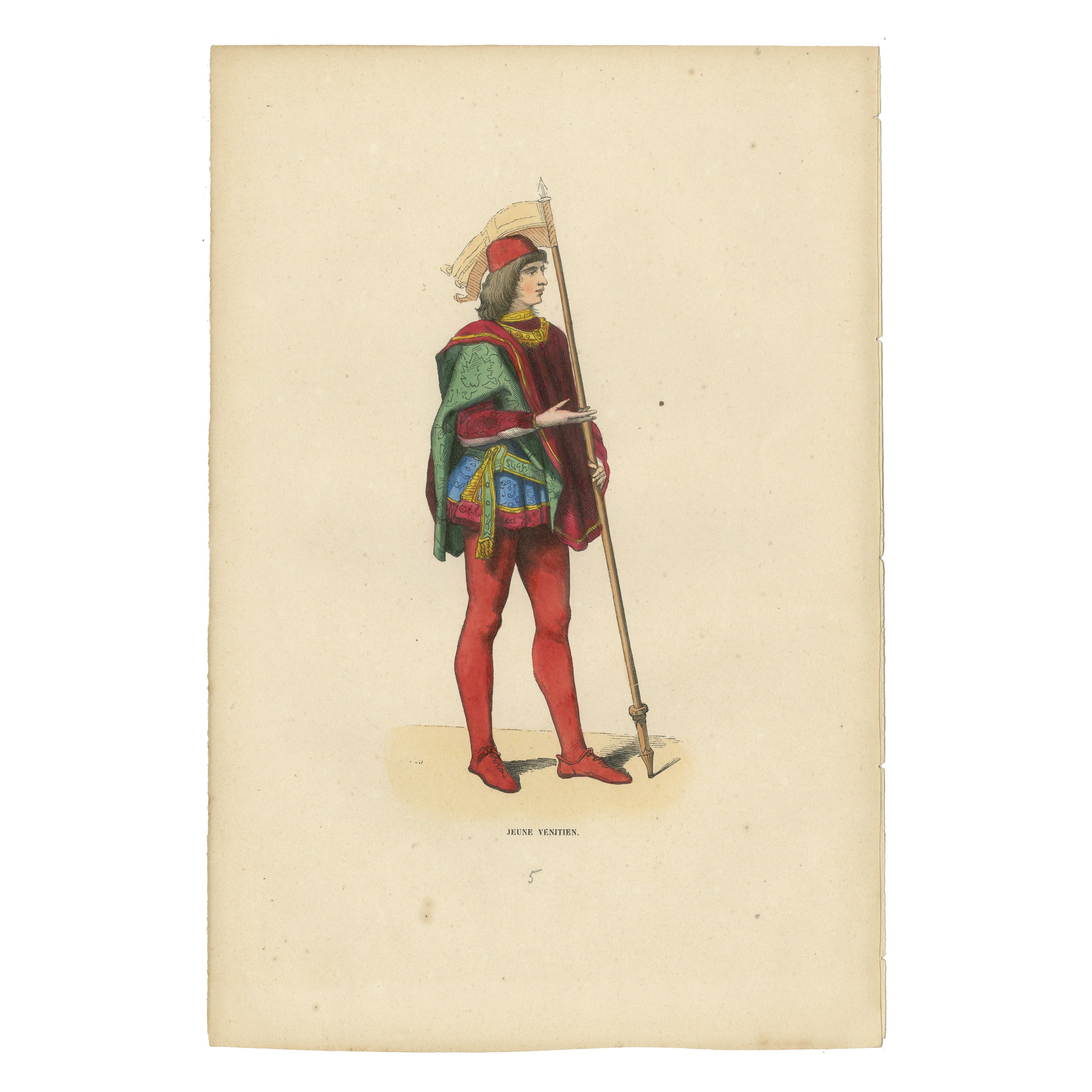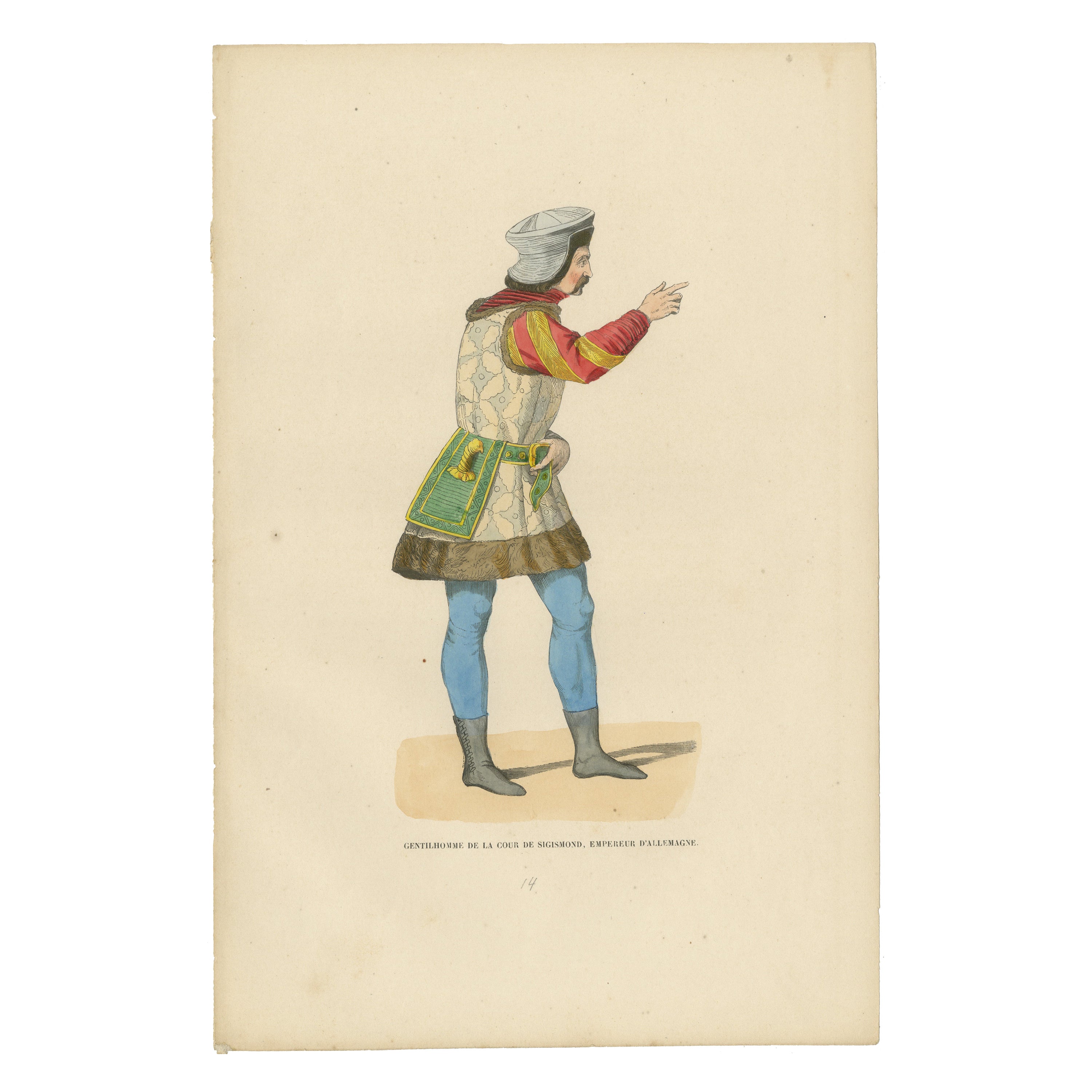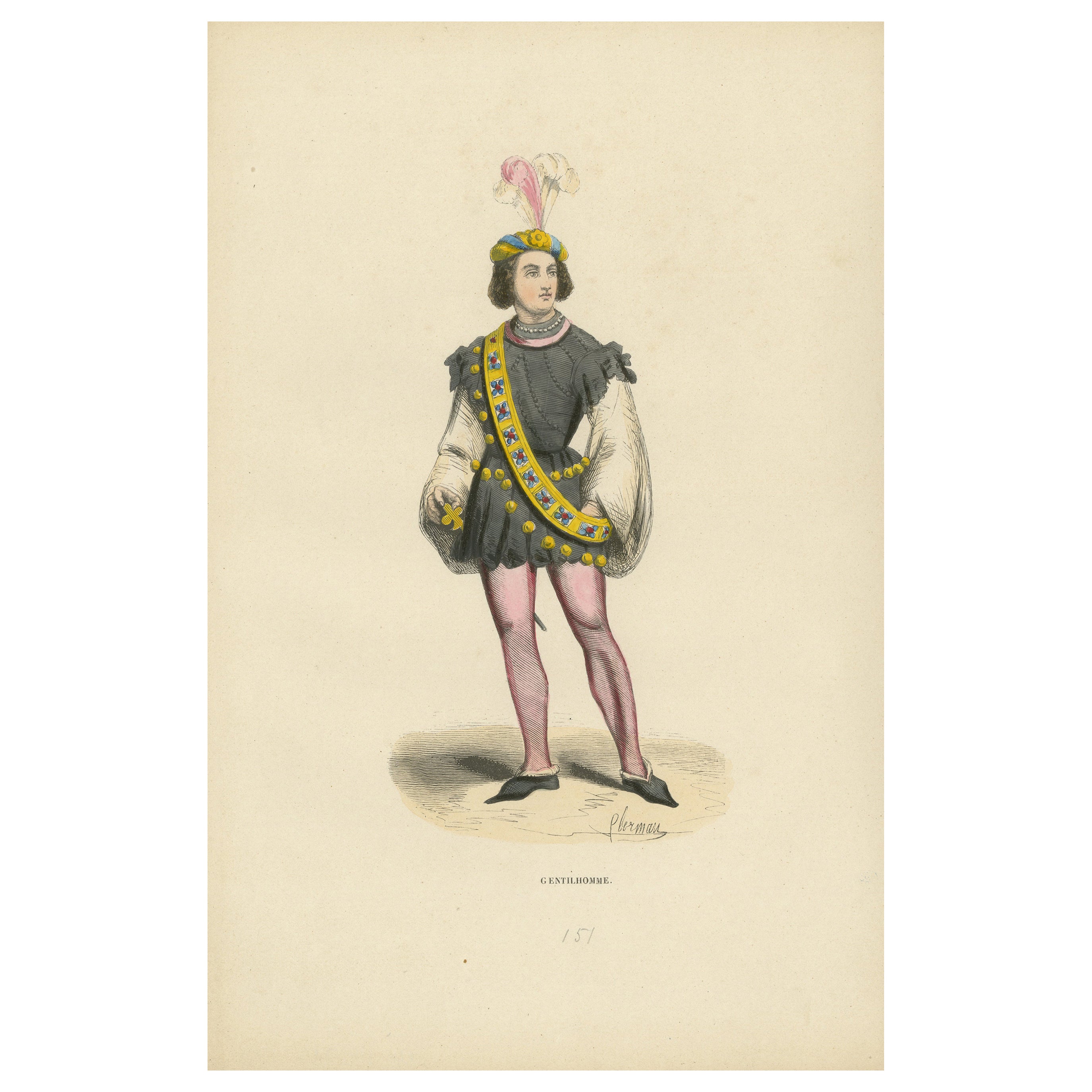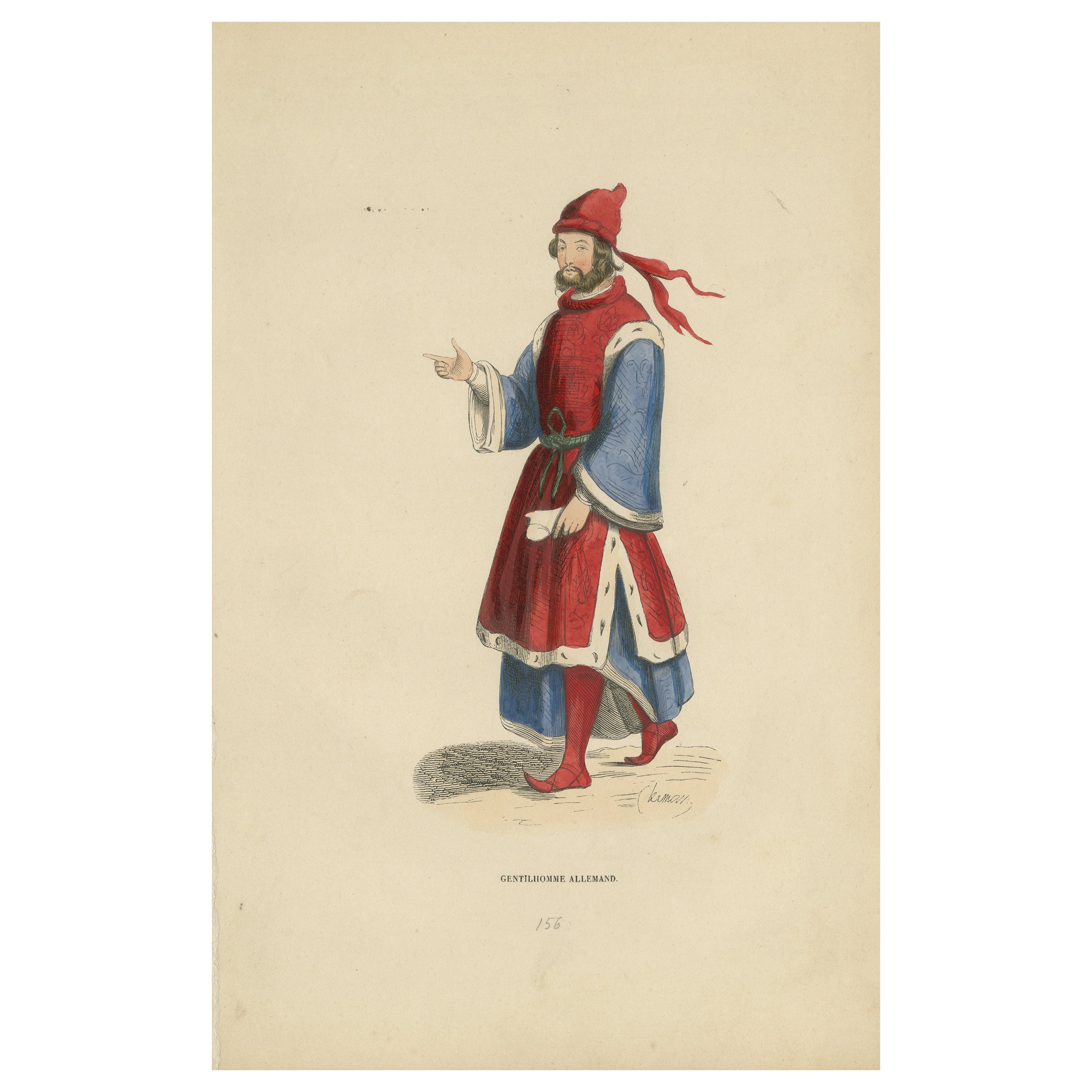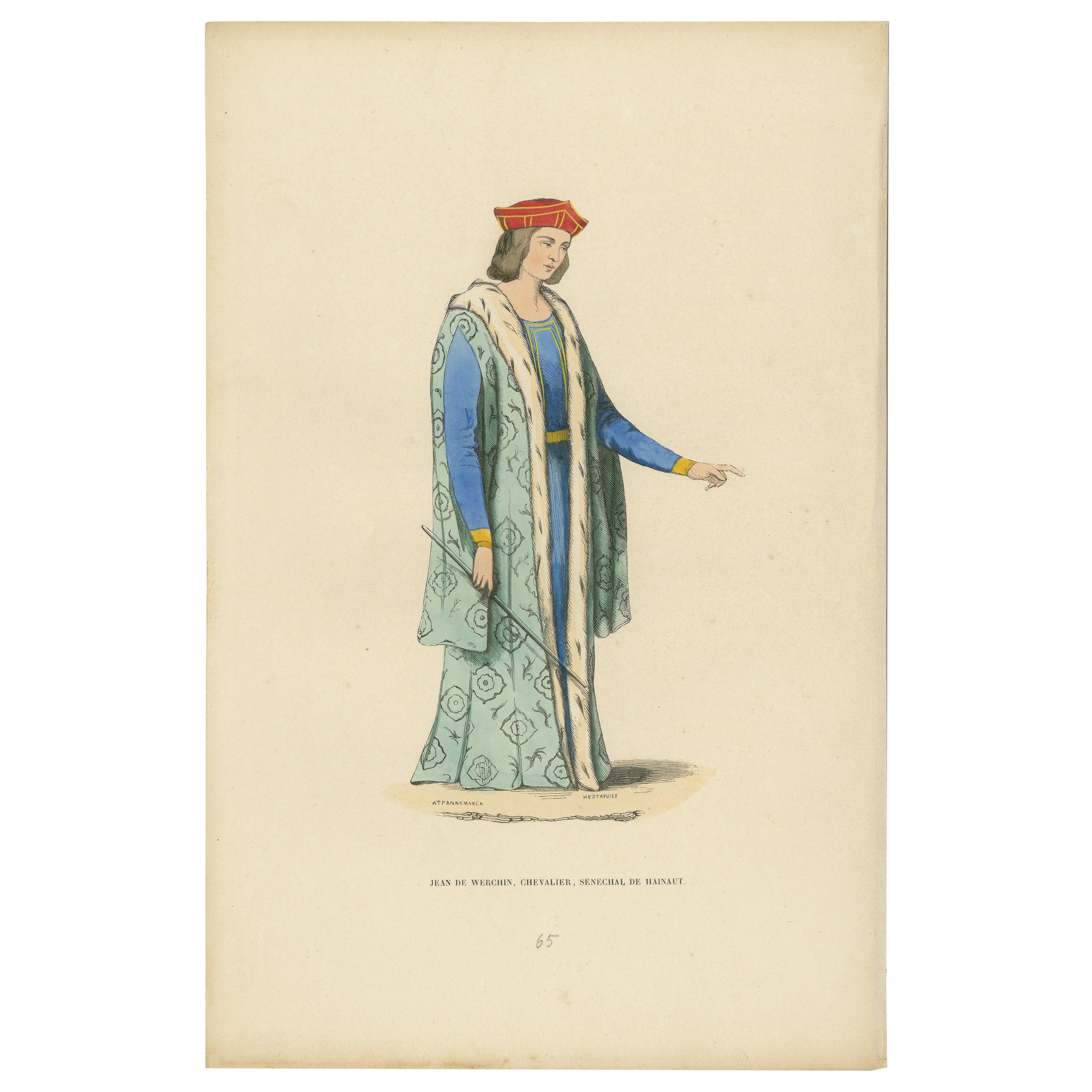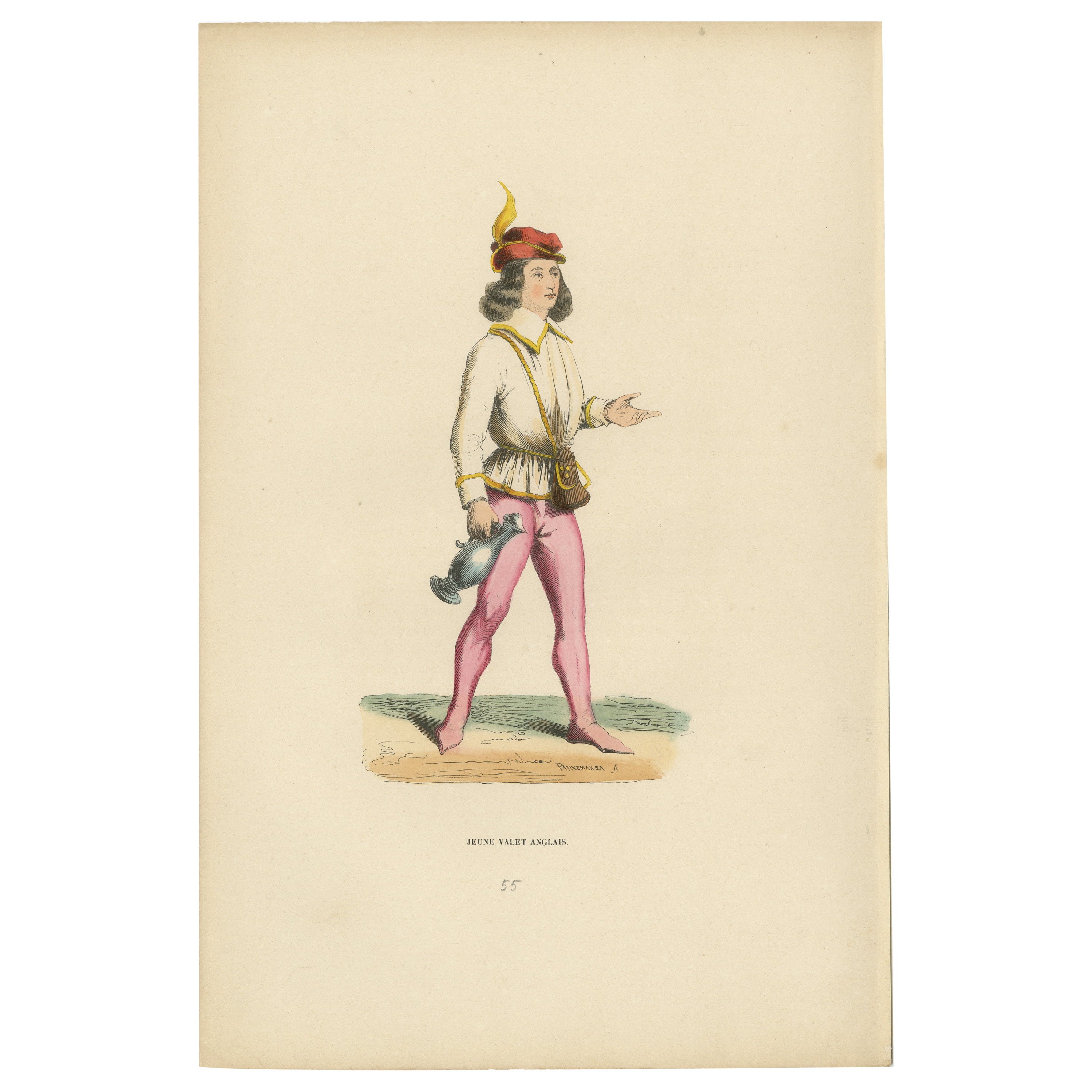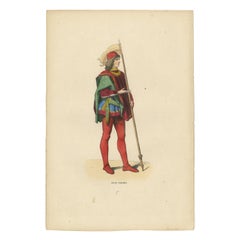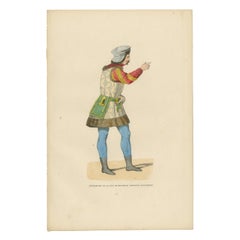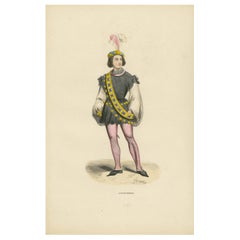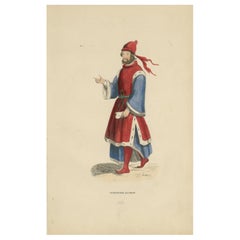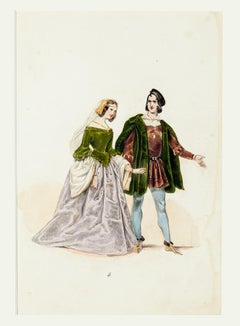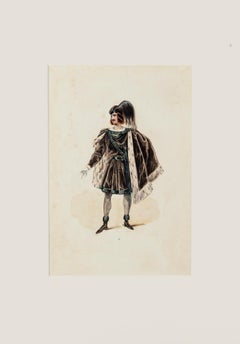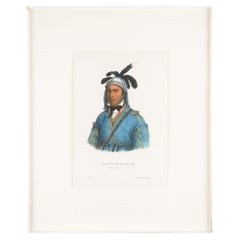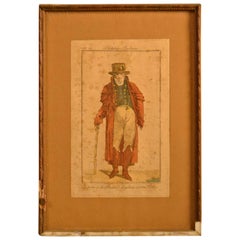Items Similar to Florentine Nobleman of the Middle Ages, 1847
Want more images or videos?
Request additional images or videos from the seller
1 of 6
Florentine Nobleman of the Middle Ages, 1847
$124.53
$155.6620% Off
£92.05
£115.0720% Off
€104
€13020% Off
CA$169.37
CA$211.7120% Off
A$189.78
A$237.2220% Off
CHF 98.79
CHF 123.4820% Off
MX$2,321.62
MX$2,902.0320% Off
NOK 1,253.90
NOK 1,567.3820% Off
SEK 1,184.30
SEK 1,480.3720% Off
DKK 791.91
DKK 989.8920% Off
Shipping
Retrieving quote...The 1stDibs Promise:
Authenticity Guarantee,
Money-Back Guarantee,
24-Hour Cancellation
About the Item
Title: "Civilian Costume at the End of the 15th Century"
Description: The image is a print from a series the "Costume du Moyen Age" dated 1847, and titled "Costume Civil de la Fin du XVe Siècle," which translates to "Civilian Costume at the End of the 15th Century." It showcases a man of status, possibly a noble or a wealthy burgher, standing in a poised and confident manner.
He is attired in an ornate cloak covered in a complex pattern of fleur-de-lis and cross motifs, indicative of wealth and possibly a connection to royalty or high social rank. The cloak is open at the front to reveal a blue doublet with a belt, and he wears red hose—a fashion staple of the late medieval period. His footwear is also red, which stands out against the more subdued tones of his outfit.
On his head, he sports a fur-trimmed hat, adding to the luxuriousness of his attire. In one hand, he holds a long staff, which serves as both a walking aid and a symbol of authority. His other hand rests on the hilt of a dagger, further indicating his readiness to defend his status or engage in the political or civic matters of his time.
The artist has skillfully rendered the textiles and accessories with great care, emphasizing the fashion and social cues of the late 15th-century European society.
The colors have a nice glow over them. Historically, egg whites, known as glair, and sometimes egg yolk were indeed used in illumination and painting, particularly in manuscripts, to give colors a brighter appearance and to add a sheen or gloss to the work. This technique was quite common during the Middle Ages and into the Renaissance.
Egg whites can be applied as a varnish over pigments to enhance their brightness and to protect the colors. This application could make the colors appear more vivid and also add a slight glossy sheen to the surface of the image.
Egg yolk, on the other hand, was commonly used as a binding agent in paint. It forms the basis of tempera paint, a medium that was widely used before the advent of oil painting. Egg yolk helps to create a durable and long-lasting color that adheres well to various surfaces.
In the context of the print from 1847, it's less likely that egg whites or yolks were used directly on the print, as by that time, commercial printing processes would have been more advanced and less reliant on such manual methods. However, if this print is a representation of an earlier style or is meant to mimic the appearance of hand-painted manuscripts, the original artists might have employed techniques or materials that gave a similar effect to those achieved with egg-based binders and varnishes.
- Dimensions:Height: 10.63 in (27 cm)Width: 7.09 in (18 cm)Depth: 0 in (0.02 mm)
- Materials and Techniques:
- Period:
- Date of Manufacture:1847
- Condition:Good. Overal light toning and light soiling but the image itself clean and hand-colored almost 200 years ago and still in expliciet colors. Aged paper with typically warm, yellowish-brown hue, mostly around the edges. Study the images carefully.
- Seller Location:Langweer, NL
- Reference Number:Seller: BG-13635-861stDibs: LU3054337906382
About the Seller
5.0
Recognized Seller
These prestigious sellers are industry leaders and represent the highest echelon for item quality and design.
Platinum Seller
Premium sellers with a 4.7+ rating and 24-hour response times
Established in 2009
1stDibs seller since 2017
2,494 sales on 1stDibs
Typical response time: 1 hour
- ShippingRetrieving quote...Shipping from: Langweer, Netherlands
- Return Policy
Authenticity Guarantee
In the unlikely event there’s an issue with an item’s authenticity, contact us within 1 year for a full refund. DetailsMoney-Back Guarantee
If your item is not as described, is damaged in transit, or does not arrive, contact us within 7 days for a full refund. Details24-Hour Cancellation
You have a 24-hour grace period in which to reconsider your purchase, with no questions asked.Vetted Professional Sellers
Our world-class sellers must adhere to strict standards for service and quality, maintaining the integrity of our listings.Price-Match Guarantee
If you find that a seller listed the same item for a lower price elsewhere, we’ll match it.Trusted Global Delivery
Our best-in-class carrier network provides specialized shipping options worldwide, including custom delivery.More From This Seller
View AllThe Elegance of Venice: A Portrait of a Young Patrician, 1847
Located in Langweer, NL
This original antique print depicts a young Venetian man, as indicated by the caption "Jeune Vénitien," which translates to "Young Venetian" from French.
The young man is dressed i...
Category
Antique 1840s Prints
Materials
Paper
$182 Sale Price
20% Off
Courtly Splendor: A Nobleman at Emperor Sigismund's Court, 1847
Located in Langweer, NL
The image depicts a man identified as a "Gentilhomme de la cour de Sigismond, empereur d'Allemagne," which translates to "Gentleman of the court of Sigismund, Emperor of Germany."
This individual is portrayed in a profile stance, dressed in attire that is indicative of the high-status courtiers during the time of Emperor Sigismund, who reigned in the early 15th century. He is wearing a turban-like headgear, which reflects the influence of Eastern fashion on European court attire, possibly due to the Ottoman influence or the general exchange of culture during the Crusades and subsequent interactions.
His doublet is richly patterned and he has puffed sleeves in red, which were fashionable among the nobility during the period. The garment is accented with a decorative belt that holds what appears to be a purse or a pouch. He also sports tight blue hose and pointed shoes, which complete the ensemble typical of a nobleman or a high-ranking court official in the Holy Roman Empire.
Egg whites can be applied as a varnish over pigments to enhance their brightness and to protect the colors. This application could make the colors appear more vivid and also add a slight glossy sheen to the surface of the image.
Egg yolk, on the other hand, was commonly used as a binding agent in paint. It forms the basis of tempera paint, a medium that was widely used before the advent of oil painting. Egg yolk helps to create a durable and long-lasting color that adheres well to various surfaces.
In the context of the print from 1847, it's less likely that egg whites or yolks were used directly on the print, as by that time, commercial printing processes would have been more advanced and less reliant on such manual methods. However, if this print is a representation of an earlier style or is meant to mimic the appearance of hand-painted manuscripts...
Category
Antique 1840s Prints
Materials
Paper
$153 Sale Price
20% Off
The Gallant Courtier: A Nobleman's Fashion in 'Costume du Moyen Âge, 1847
Located in Langweer, NL
Title: "The Gallant Courtier: A Nobleman's Fashion in 'Costume du Moyen Âge'"
Description: This 1847 lithograph from the "Costume du Moyen Âge" collection depicts a nobleman dressed...
Category
Antique 1840s Prints
Materials
Paper
$134 Sale Price
20% Off
Noble Bearing: A German Gentleman in Medieval Attire, 1847
Located in Langweer, NL
Title: "Noble Bearing: A German Gentleman in Medieval Attire from 'Costume du Moyen Âge'"
Description: This 1847 lithograph from the esteemed collection "Costume du Moyen Âge" showc...
Category
Antique 1840s Prints
Materials
Paper
$172 Sale Price
20% Off
Jean de Werchin, a Knight and Seneschal of Hainaut: The Knight's Poise, 1847
Located in Langweer, NL
Title: "Jean de Werchin: The Knight's Poise"
Description: This print illustrates Jean de Werchin, a knight and seneschal of Hainaut, captured in a moment of courtly grace. His postu...
Category
Antique 1840s Prints
Materials
Paper
$114 Sale Price
20% Off
The English Squire: A Portrait of Service and Style, Original Engraving of 1847
Located in Langweer, NL
This antique hand-colored print originates from the same "Costume du Moyen Age" series from 1847 and depicts a young English squire, an attendant to a knight during the medieval peri...
Category
Antique 1840s Prints
Materials
Paper
$124 Sale Price
20% Off
You May Also Like
Ancient Costume - Original Lithograph - Mid 19th Century
Located in Roma, IT
Ancient Costume is an original lithograph hand-colored, realized by an anonymous artist of the XIX century
The state of preservation of the artwork is...
Category
Mid-19th Century Figurative Prints
Materials
Lithograph
Costume - Original Hand-Colored Lithograph - 19th Century
Located in Roma, IT
Costume is original Hand-colored lithograph realized by an Anonymous artist in the late XIX century.
Included a Passepartout: 52.5 x 37cm.
Very good conditions.
The artwork represents the traditional costume, skillfully depicted through soft and precise strokes, the artwork is created with congruous harmonious colors from historical costume...
Category
19th Century Figurative Prints
Materials
Lithograph
O-Poth-Le-Yo-Ho-Lo by McKinney & Hall, 1842
Located in Kenilworth, IL
Hand colored lithograph portrait of "O-Poth-Le-Yo-Ho-Lo," a Creek Chief & speaker of the Councils, after the oil on canvas portrait by Charles Bird King. The lithographic portrait is from McKinney...
Category
Antique 1840s American Prints
Materials
Paper
18th Century, Framed Fashion Engraving
Located in Vista, CA
18th Century framed fashion engraving. Gilding on frame is damaged (see picture).
Category
Antique 18th Century and Earlier French Drawings
Materials
Giltwood, Glass
Imerethian Prince - Lithograph by Auguste Wahlen - 1844
Located in Roma, IT
Imerethian Prince is a lithograph made by Auguste Wahlen in 1844.
Hand colored.
Good condition.
At the center of the artwork is the original title "Imerethian Prince".
The work i...
Category
1840s Modern Figurative Prints
Materials
Lithograph
Cavalier - Hand-Colored Lithograph - 19th Century
Located in Roma, IT
Cavalier is an original hand-colored lithograph on paper realized by an Anonymous artist of the XIX century, it represents a cavalier in his particular costume with shield through ha...
Category
19th Century Modern Portrait Prints
Materials
Lithograph
More Ways To Browse
Ornate Belt
Fur Hat Used
Antique Silver Boxes Repousse
Antique Storm Glass
Antique Thimbles
Antique Victorian Grandfather Clock
Antique Wooden Swan
Art Deco Bed Frame Queen
Art Deco Buffet Mirror
Art Deco Desk Statue
Art Deco Full Bed
Art Deco Glass Shelving
Astronomical Clock
Baker Dining Buffet
Baker Neoclassical Dining
Baker New World Collection
Baroque Headboard
Bear Bookends
